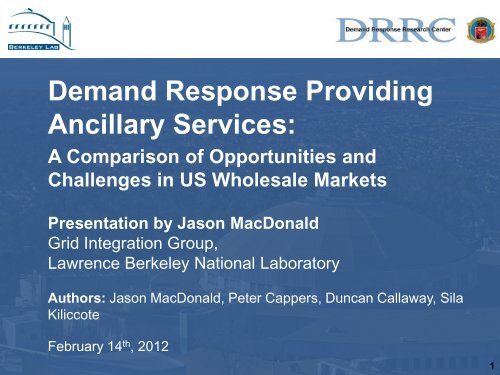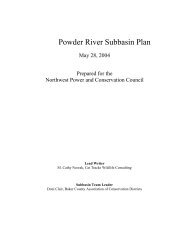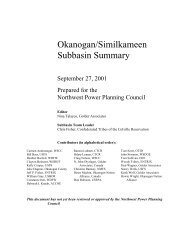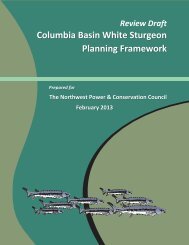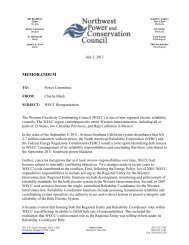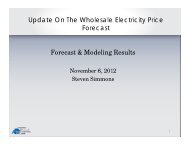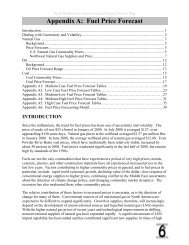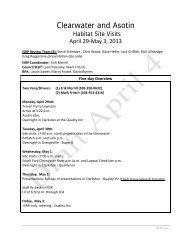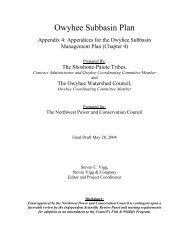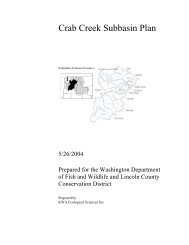Jason MacDonald, LBNL
Jason MacDonald, LBNL
Jason MacDonald, LBNL
You also want an ePaper? Increase the reach of your titles
YUMPU automatically turns print PDFs into web optimized ePapers that Google loves.
Demand Response Providing<br />
Ancillary Services:<br />
A Comparison of Opportunities and<br />
Challenges in US Wholesale Markets<br />
Presentation by <strong>Jason</strong> <strong>MacDonald</strong><br />
Grid Integration Group,<br />
Lawrence Berkeley National Laboratory<br />
Authors: <strong>Jason</strong> <strong>MacDonald</strong>, Peter Cappers, Duncan Callaway, Sila<br />
Kiliccote<br />
February 14 th , 2012<br />
1
• Introduction<br />
– Wholesale Markets and AS<br />
– Why DR for AS?<br />
– Market Clearing Price<br />
• Value in Markets<br />
Contents<br />
– Average AS Market Clearing Prices<br />
– Market Clearing Price Trends<br />
– Market Size<br />
• AS Market Rules affecting DR Participation<br />
– Resource Size<br />
– M&V<br />
• Concluding Remarks<br />
2
Ancillary Services in US ISO/RTOs<br />
• ISO/RTOs are balancing authorities that run open wholesale markets for both<br />
energy and Ancillary Services (AS)<br />
• AS maintain reliable functioning of the bulk power system<br />
• AS in ISO/RTO markets<br />
include:<br />
– Frequency Regulation<br />
– Spinning Reserve<br />
– Non-Spinning Reserve<br />
– Supplemental Reserve<br />
• AS traded in markets are<br />
capacity reserve products<br />
• Expressed in units of MW-h, one MW held in reserve for one hour<br />
Source: FERC.gov<br />
3
Ancillary Services in US ISO/RTOs<br />
• ISO/RTOs are balancing authorities that run open wholesale markets for both<br />
energy and Ancillary Services (AS)<br />
• AS maintain reliable functioning of the bulk power system<br />
• AS in ISO/RTO markets<br />
include:<br />
– Frequency Regulation<br />
– Spinning Reserve<br />
– Non-Spinning Reserve<br />
– Supplemental Reserve<br />
• AS traded in markets are<br />
capacity reserve products<br />
• Expressed in units of MW-h, one MW held in reserve for one hour<br />
Source: FERC.gov<br />
4
Why DR for AS?<br />
• Qualities of DR resources may provide some benefits to<br />
the system:<br />
– Very fast (extremely high ramp rates)<br />
– Cheap to operate (likely price takers)<br />
– Statistical reliability (property of large aggregations of small<br />
resources)<br />
– Fast to market (very few siting/permitting issues)<br />
– Controllable, distributed resource near load served<br />
5
What is the Market Clearing Price?<br />
Price [$/MW-h]<br />
Market<br />
Clearing<br />
Price<br />
Required AS<br />
Capacity<br />
Resource Cost<br />
Curve (Bid Curve)<br />
Capacity [MW-h]<br />
• Resource Cost = sum of its lost opportunity cost and availability bid<br />
• The Market Clearing Price (MCP) is paid to every resource that is<br />
economic<br />
6
Average Annual MCPs<br />
* Below the red line is Regulation Up and above is Regulation Down<br />
Spinning Reserve – CAISO (South)<br />
Regulation - NYISO<br />
Examining monthly<br />
average MCP’s<br />
illustrates that<br />
sometimes seasonal<br />
trends may dominate<br />
annual trends<br />
7
Daily Trends in MCP<br />
• Daily Trends in MCP show more<br />
seasonal effects.<br />
• Additionally, daily trends indicate<br />
additional opportunity for loads<br />
that can provide AS during hours<br />
of higher price.<br />
Southern California Data (Winter and Summer Prices)<br />
Source: California Commercial End Use Survey (CEC)<br />
8
Market Size<br />
• Two procurement<br />
mechanisms:<br />
• In markets<br />
• self-scheduled<br />
• Absolute market<br />
procurement is in the<br />
hundreds of MW.<br />
Annual Market Size<br />
[M$/yr] CAISO-S CAISO-N ERCOT MISO PJM<br />
2009 - - 105 - 160<br />
Regulation 2010 12 12 118 43 126<br />
2011 18 12 152 38 123<br />
2009 - - 119 - 24<br />
Spinning<br />
2010 11 14 122 33 32<br />
Reserve<br />
2011 19 18 462 23 51<br />
• Market Size =<br />
∑Procurement(t)*MCP(t)<br />
• PJM spinning reserve market size<br />
based on Mid-Atlantic Reserve<br />
Zone<br />
9
Market Rules: Resource Size<br />
• DR resources are smaller than traditional grid resources<br />
• DR resources are not symmetric in their ability to shed and<br />
take load<br />
• Some DR Resources are limited in the length of response at<br />
full power<br />
Regulation Rules<br />
Min. Size<br />
(MW)<br />
Aggregation<br />
Allowed<br />
Symmetric<br />
Bid Req’d<br />
Continuous<br />
Energy Period<br />
CAISO** 0.5 No No 60 min<br />
ERCOT 0.1 No*** No NA<br />
MISO 1 No Yes 60 min<br />
PJM 0.1 Yes* Yes NA<br />
NYISO 1 No Yes NA<br />
ISO-NE NA*** NA*** NA NA<br />
*Requires approval.<br />
** Forthcoming, WECC does not currently allow demand side resources to provide this product.<br />
*** Pilots are underway to examine the ability to change this rule.<br />
Spinning Reserve Rules<br />
Min. Size<br />
(MW)<br />
Aggregation<br />
Allowed<br />
Continuous<br />
Energy Period<br />
CAISO** 0.5 No 30 min<br />
ERCOT 0.1 No*** NA<br />
MISO 1 Yes 60 min<br />
PJM 0.1 Yes* NA<br />
NYISO 1 No 60 min<br />
ISO-NE 1 Yes NA<br />
10
Market Rules: M&V<br />
• DR is more cost effective with less stringent M&V requirements<br />
– Accuracy requirements are different for revenue metering and telemetry, but<br />
cost may dictate that the same device perform both functions<br />
– Telemetry is necessary for regulation, but in some cases, also required for<br />
Spinning Reserve<br />
– Maintaining data for every DR resource in an aggregation is resource<br />
intensive<br />
Telemetry Rate<br />
Revenue Metering<br />
Accuracy<br />
Telemetry<br />
for Spin Res<br />
Data Source<br />
Level<br />
CAISO 4 sec +/- 0.25% Yes Resource<br />
ERCOT 3-5 sec +/- 2% No Aggregate<br />
MISO 4 sec State Spec Yes Resource<br />
PJM 2 sec* +/- 2% No Aggregate<br />
NYISO 6 sec +/- 2% Yes Resource<br />
ISO-NE 10 sec +/- 0.5% Yes Resource<br />
*Can be batch sent once every minute<br />
11
Concluding Remarks<br />
• Wide range in AS value between ISO/RTOs, although<br />
relatively thin.<br />
• Currently, the most favorable wholesale AS market<br />
conditions for DR exist at PJM and ERCOT.<br />
• Reducing the minimum resource size and allowing<br />
aggregation may be the most important rules for<br />
promoting DR participation in AS.<br />
• Ancillary services will be one of a portfolio of applications<br />
of fast demand response.<br />
12
Questions?<br />
Contact :<br />
<strong>Jason</strong> <strong>MacDonald</strong><br />
jsmacdonald@lbl.gov<br />
Reference paper (presented at Grid Interop 2012):<br />
http://drrc.lbl.gov/sites/drrc.lbl.gov/files/<strong>LBNL</strong>-5958E.pdf<br />
This work was coordinated by the Consortium for Electric Reliability<br />
Technology Solutions and was funded by the Office of Electricity<br />
Delivery and Energy Reliability, Transmission Reliability Program of the<br />
U.S. Department of Energy under Contract No. DE-AC02-05CH11231<br />
13


